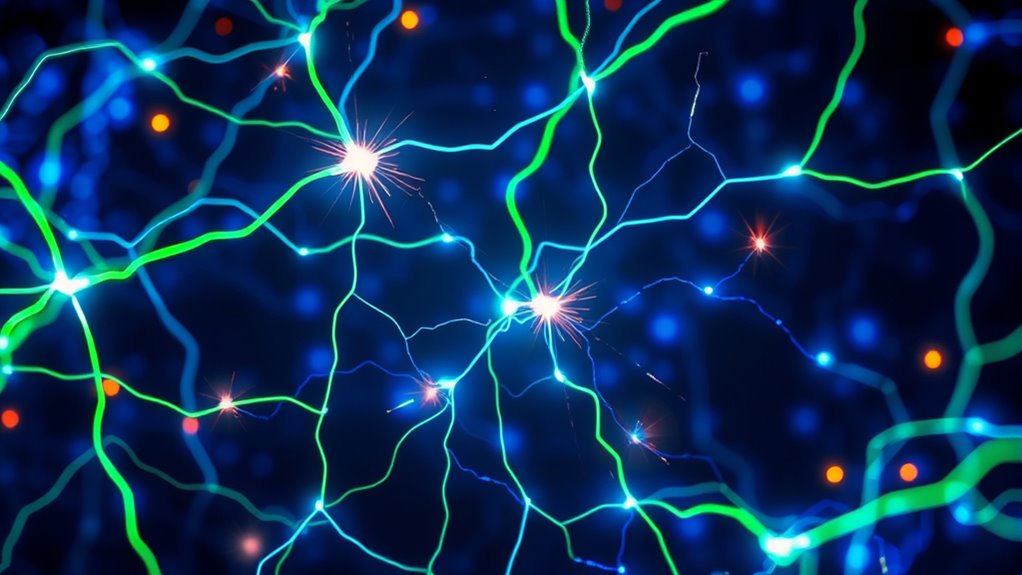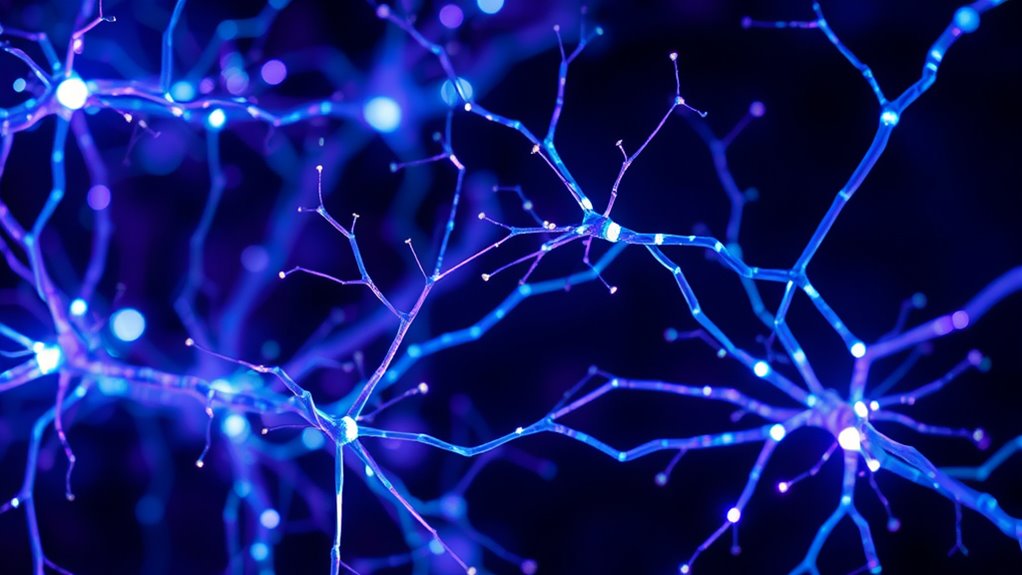Stimulating your brain with new experiences rewires neural pathways, boosting your creativity and mental flexibility. When you challenge yourself with unfamiliar hobbies or ideas, you disrupt old thought patterns and build new connections. This process enhances your brain’s ability to adapt and see things from different angles. By regularly introducing novelty, you keep your mind agile and open to innovation. Keep exploring, and you’ll discover more ways to unseal your full creative potential.
Key Takeaways
- Novelty stimulates brain plasticity, creating new neural connections that disrupt habitual thought patterns.
- Engaging with unfamiliar experiences enhances cognitive flexibility, allowing for diverse problem-solving approaches.
- Introducing new stimuli rewires neural pathways, reducing mental inertia and fostering innovative thinking.
- Repeated exposure to novelty increases mental agility, supporting continuous creative growth and adaptability.
- Leveraging brain plasticity through novelty unlocks hidden creative potential and sustains ongoing mental renewal.

Sometimes, your brain needs a fresh start to break free from old habits or persistent mental blocks. This is where understanding brain plasticity and cognitive flexibility becomes vital. Brain plasticity, or neuroplasticity, refers to your brain’s remarkable ability to reorganize itself by forming new neural connections throughout your life. It’s the foundation that allows you to learn new skills, adapt to changing circumstances, and recover from injuries. Cognitive flexibility, on the other hand, is your capacity to shift your thinking, adapt to new information, and approach problems from different angles. When you intentionally stimulate this flexibility, you open the door to a reset that can dramatically boost your creativity.
Stimulate brain plasticity and cognitive flexibility to reset mental blocks and unlock your creative potential.
Engaging in novel experiences triggers your brain’s plasticity in powerful ways. When you expose yourself to something unfamiliar—be it a new hobby, a different perspective, or an unconventional problem-solving method—you create new pathways in your neural network. These new connections disrupt the habitual patterns of thought that often limit your creativity. Instead of relying on well-worn mental routes, you encourage your brain to forge fresh links, making it more adaptable and open-minded. This process not only helps break mental ruts but also enhances your overall flexibility in thinking.
By deliberately seeking out novelty, you activate your brain’s capacity to remodel itself. For example, learning a new language, picking up a fresh artistic style, or exploring unfamiliar topics can boost your cognitive flexibility. When your brain is constantly challenged with new stimuli, it becomes less rigid and more receptive to innovative ideas. As a result, you find it easier to connect disparate concepts, synthesize information creatively, and generate novel solutions. This mental agility is vital for expanding your creative potential, especially when faced with complex or unfamiliar challenges.
Moreover, this reset isn’t just about gaining new insights; it’s about rewiring your habitual thought patterns. The more you expose yourself to novel experiences, the more your brain adapts to think flexibly and embrace change. Over time, this reduces mental inertia, making it easier to pivot when needed and fostering a mindset that thrives on innovation. Additionally, understanding the concept of brain plasticity emphasizes how adaptable your neural network can be when stimulated appropriately. Essentially, by leveraging brain plasticity and cultivating cognitive flexibility, you can refresh your neural pathways and unleash a wellspring of creativity that felt out of reach before. The key is to consistently challenge your brain with new, stimulating experiences—your neural network will thank you.
Frequently Asked Questions
How Long Does a Neural Pathway Reset Typically Take?
You wonder how long a neural pathway reset takes, but it varies based on neural plasticity and your efforts. Typically, with new experiences and learning, neural pathways can adapt within days to weeks. Engaging in novel activities enhances cognitive flexibility, speeding up this process. Consistent practice and exposure to variety help your brain rewire more efficiently, making the reset quicker and boosting your creativity over time.
Can Neural Pathway Resets Be Harmful or Cause Side Effects?
Think of neural pathway resets like updating your phone’s software—they’re generally safe, but sometimes, they can cause issues. While rare, resets might lead to neural damage or unexpected side effects, especially if done improperly. Long-term effects are usually minimal, but it’s wise to consult a professional before attempting any drastic changes. Overall, if done correctly, resets can boost your creativity without harming your brain.
Are There Specific Activities That Promote More Effective Resets?
You might wonder if certain activities help your brain reset more effectively. Engaging in mindfulness meditation calms your mind and clears mental clutter, making resets more impactful. Creative journaling stimulates your imagination and encourages new perspectives. Combining these activities allows you to refresh your neural pathways efficiently, fostering greater creativity and mental clarity. Regular practice enhances your ability to adapt and innovate through more effective neural pathway resets.
How Does Age Affect the Ability to Reset Neural Pathways?
When it comes to resetting neural pathways, age can be a tough nut to crack. As you get older, neural plasticity—the brain’s ability to change—declines, making it harder to form new connections. But don’t count yourself out; engaging in novel activities can still stimulate your brain. While age-related decline presents challenges, your brain can adapt and grow, especially if you keep embracing new experiences.
Is Neural Pathway Resetting Effective for Mental Health Issues?
You might wonder if neural pathway resetting helps with mental health issues. It can be effective because it taps into neural plasticity, allowing your brain to form new, healthier connections. This process can boost emotional resilience, helping you better handle stress and negative thoughts. By introducing novelty, you encourage your brain to adapt and heal, making neural pathway resetting a promising approach for improving mental well-being.
Conclusion
By consciously resetting your neural pathways, you open doors to daring discoveries and delightful diversions. Embrace the ease of exploring new ideas, escaping old patterns, and energizing your creativity. When you refresh and reframe, your mind becomes a maze of marvelous, meaningful moments. So, stay curious, stay committed, and let your neural network nurture new notions. Remember, a simple reset sparks splendid, surprising, and sustainable strides toward your most inventive self.











